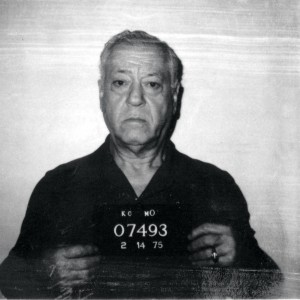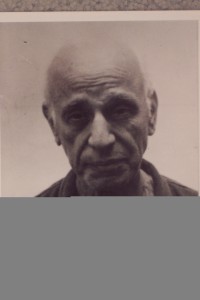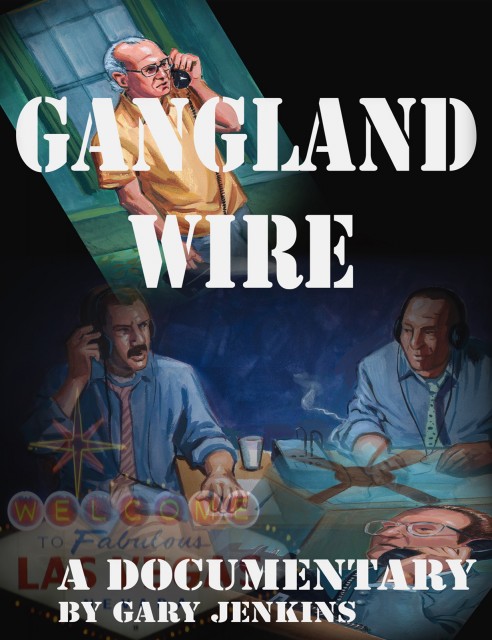Gangland Wire
 Gangland Wire documents the investigation and fall of the four Midwest Mob families. Those families have never fully recovered from that fall. They lost control of the billion- dollar Central States Teamster Pension Fund and a steady flow of millions in cash from Las Vegas casinos.
Gangland Wire documents the investigation and fall of the four Midwest Mob families. Those families have never fully recovered from that fall. They lost control of the billion- dollar Central States Teamster Pension Fund and a steady flow of millions in cash from Las Vegas casinos.
The film’s producer, Gary Jenkins, was an Intelligence Unit detective with the Kansas City Police Department. Gangland Wire begins with Gary’s experts telling insider stories about a local mob squabble that escalated into several murders and bombings. Because of this Kansas City mob war, investigators placed a microphone in a Kansas City tavern named the Villa Capri. Gary was able to obtain actual recordings from F.B.I. archives.
Starting with that Villa Capri conversation, the Kansas City F.B.I., with the help of Kansas City Police Intelligence Unit, entered into an investigation that uncovered a national conspiracy of the Midwest La Cosa Nostra families using Teamster’s pension fund money to finance Las Vegas casino owners. The price for casino owners to obtain loan approvals was high. Chicago, Cleveland, Chicago and Kansas City mob bosses ordered “strawman” casino owners to give casino jobs to mob pawns. These mob underlings skimmed cash from the counting rooms and sent it back to the Midwest Mob.
Jenkins was able to obtain hours of the recordings used as evidence to convict the La Cosa Nostra bosses in Chicago, Milwaukee, Cleveland and Kansas City for this conspiracy to skim. He made extensive use of the audio clips in Gangland Wire. The viewer will hear out of the mobster’s own mouths just how they conducted their business.
For the documentary, Gary obtained copies of ledger notes kept by Tuffy DeLuna (Artie Piscano in Casino) about the Mob’s Las Vegas activities. Tuffy’s notes showed how he kept records about his secret Las Vegas trips to threaten a casino owner. Tuffy kept track of his overall travel, meetings, cryptic comments about the meetings tips and parking paid. Gangland Wire contains a recording of Tuffy telling fellow mobsters how he was preparing his wife for his eventual jail sentence.
Gorilla Convict sat down with filmmaker Gary Jenkins to talk about his film.
Why did you make the film?
I made the film because I and several police and FBI friends were assigned to the investigation. We always felt that Scorsese focused on a soap opera story with the DeNiro character and Stone. While we knew the skim was up together with the Midwest mobs and overseen by Tuffy DeLuna, KC Underboss. I wanted to tell the KC end of the story.
What role did you play on the film?
I was the Executive Producer as well as the Producer and Editor. I hired a local videographer, Anthony Ladesich, narrator Bill Kalahurka, musicians Paul Kim and Stan Kessler and a sound guy, Craig Retmer, to place the music in the right spots as well as sound effects.
 What other films do you have out?
What other films do you have out?
I have 2 other docs out. The first was titled, Negros to Hire: Slave Life on Antebellum Missouri Farms. The second was Freedom Seekers: Stories From the Western Undergrund Railroad.
What’s your background?
I retired from KCPD and went to law school. I have practiced law since 2000. I am self taught on creating docs. I learned by making docs as a volunteer for a local Hospice. I would film interviews of the dying patients, then put their family photos and video in as the B roll and use whatever popular music they requested. I learned about the Mob as a police officer assigned to investigate the KC Mob.
How long did the documentary take to make?
It took about 2 years of part time work. I wanted to use audio from the wiretaps and hidden mikes used during the Strawman investigation. (The investigation into skimming from Vegas Casinos was code named Strawman) I had to file a motion with the federal court to obtain a court order to obtain the recordings that had been placed into evidence at the trials. I flew my camera guy out to Las Vegas to interview gaming folks, retired agents, former employees and a college professor expert on this history.
What can a viewer learn from watching your film?
The viewer will learn how Mafia guys think and talk because I used their own words to tell much of how they got into the casinos, the problems they had while they skimmed, exactly how they skimmed and what they felt after they were served search warrants for skim evidence.
What was the deal with the Kansas City Mafia?
The KC Mob upper echelon were quiet and low key personally. They drove mid size mid priced cars. They were feared and respected by most of the professional mob criminal associates. If they were cheated or crossed in any manner, they took quick action. They had a lot of power through their control of the Teamsters union and this steady flow of over $40,000 a month from the Casinos. Their direct political power was waning but they still had some in the 70s.
 Who was the boss of the family?
Who was the boss of the family?
Nick Civella was the overall boss since 1957. His brother, Carl “Cork” Civella was his advisor. Carl “Tuffy” DeLuna was his Underboss. There was a main guy named Willie “Willie the Rat” Camissano who had a crew that handled all the fencing of stolen property out of 2 or 3 different retail outlets. Willie was a killer and enforcer also. There were several made guys who all shared in the skim. About 10 I think. Charles Moretina was a made guy who was close to Tuffy and helped with important hits and with the skim.
How does your film compare to Casino?
I think my film is different from Casino in that I tell the story of a local mob war between an upstart crew and th Civella family. This drew extra FBI attention and was the reason there was a hidden microphone in th Villa Capri bar where agents overheard Tuffy and Corky discussing Las Vegas Casino activities. This led to other wire taps that uncovered the skimming. Casino focuses mainly on the relationship between the Ace Rothsten and his wife and the activities of the Joe Pesci character who was portraying Tony Spilotro. My film does not go into any of that.
Who were the big wigs of the KC Mob?
The most important are Nick Civella and Tuffy DeLuna and their moles inside the Tropicana casino, Joe Agosto and Carl Thomas. Lefty Rosenthal was very important but I had no wiretaps with him talking. He was a top echelon FBI informant. Chicago mobster Joseph “Joey the Clown” Lombardo was an important Chicago mob boss who is on a wiretap in the film. He threatens casino owner Morris Shenker with death if he does not pay a kickback to Teamster official, Allen Dorfman. His boss was never on the wire but convicted for skimming. His name was Joseph “Joey Doves” Aiuppa. Milwaukee mob boss Frank Balisteri and Cleveland mobster Mashie Rockman were convicted of helping with the skim.
Describe the Kansas City mob and what they were into?
In the area of fencing this stolen property, they supplied three or 4 store front locations.One lucrative operation was Tiger’s Records store. Mob member “Tiger” Cardarella worked with professional boosters and was one of the most successful record stores in the city during the 1960s to the early 1980s. Junior Bradley had a store that sold over the counter medications, film, razor blades, perfume and other like items. These were all boosted from department stores.
By the 1970s when drugs became so easy to get, both the individuals established a side relationship with a drug dealer and they were soon paying the boosters off with drugs. Jerry Stephens ran small store front clothing outfit. During this time, the main source of income was from sports gambling and has continued to the present day to be a source of Mob income.
To learn more or buy the DVD go here.
If you like this then check out Criminal Journalism.



